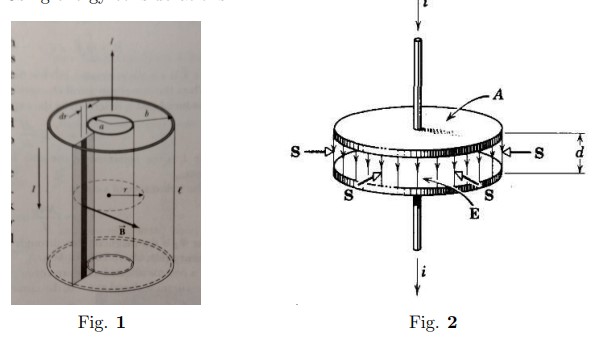Electrodynamics Apr 14, 2018
Tutorial-V
- A cylindrical resistor of length \(\ell\), radius \(a\) and resistivity $\varrho$ is carrying a current \(i\).
- Show that the Poynting vector $\vec{S}$ at the surface of the resistor is everywhere directed to the normal to the curved surface.
- Show the rate $\rho$ at which energy flows into the resistor through its cylindrical surface, calculated by integrating the Poynting vector over this surface, is equal to the rate at which Joule heat is produced, i.e. \begin{equation*} \int\vec{S}\cdot\vec{dA}=i^2R \end{equation*}
- A long coaxial cable consists of two concentric conductors of radii \(a,b\) and length \(\ell\), see \Figref{Cable-Self-Ind}. The inner conductor is assumed to be a thin cylindrical shell. The conductors carry currents in opposite directions. Calculate self inductance of this cable in two ways:
- Using the definition of self inductance
- Using energy considerations.

- \Figref{Capacitor} shows a parallel-plate capacitor being charged,
- Show that the Poynting vector \(S\) points everywhere radially into the cylindrical volume.
- Show that the rate \(P\) at which energy flows into this volume, calculated by integrating the Poynting vector over the cylindrical boundary of this volume, is equal to the rate at which the stored electrostatic energy increases; that is, that \[\int \vec{S}\cdot\vec{dA} = A d \frac{1}{2}\frac{d}{dt}(\epsilon \vec{E}^2)\],where \(Ad\) is the volume of the capacitor and \(\frac{1}{2} \epsilon_0\vec{E}^2\) is the energy density for all points within that volume. This analysis shows that, according to the Poynting vector point of view, the energy stored in a capacitor does not enter it through the wires but through the space around the wires and the plates. \{Hint: To find \(S\) we must first find \(B\), which is the magnetic field setup by the displacement current during the charging process; Ignore fringing of the lines of \(E\).)\}
- What happens when the current is taken to flow in the opposite direction?
- The Sun delvers about 1000 W/m\(^2\) of energy to earth's surface.
- Compute the power incident on a roof of dimension 5.0m\(\times\)8.0 m.
- Determine the radiation pressure and radiation force on the roof,assuming that the roof is a perfect absorber. \end{AlphaList1} You may assume that the Sun's rays are incident at 90\(^o\) on the roof. % Serway and Jerwett p315
Exclude node summary :
n
Exclude node links:
0
4727:Diamond Point
0






 ||Message]
||Message]
